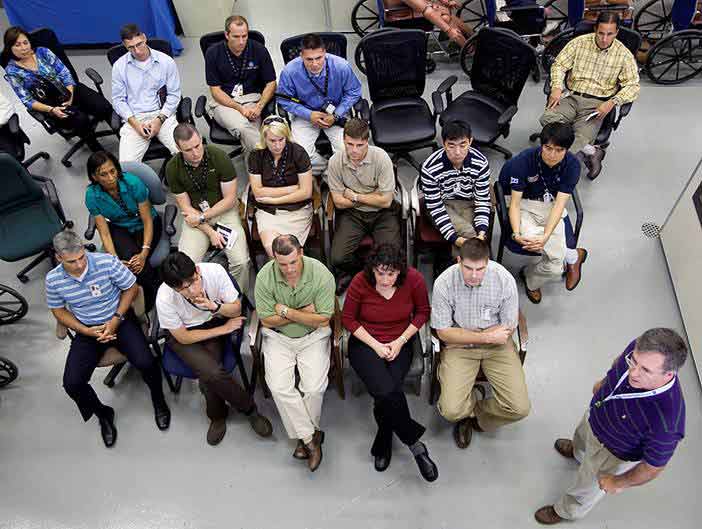NASA's New Astronauts: Call Them the 'Chumps'

Since reporting to the Johnson Space Center in mid August tobegin training, NASA's nine new astronaut candidates and five internationaltrainees from Canada and Japan have been referred to collectively as either the2009 class of astronaut candidates ("ascans") or NASA's 20th group oftrainees.
As of earlier this month though, the 14 can be called the"Chumps."
"We learned about the class name at a party hosted inour honor by the class of 2004 on Saturday, October 3," explained "Chump"Mark Vande Hei in an e-mail to collectSPACE.com whilehe and his classmates were away in Florida for water survival training.
Following a tradition that dates back a couple of decades,the incoming astronauts were nicknamed by the previous class, in this caseGroup 19 or the "Peacocks."
This time however, the 2009 ascansthought they could steer the selection by decorating their office and generallycampaigning for their self-chosen name, the "Chimps."
"[2004 astronaut] Shane Kimbrough first talked abouthow the Peacocks had come up with many naming ideas for our class, butcommended us for doing such a great job lobbying to be called the 'Chimps.'Instead they flipped over a placard that said 'Chumps.' It was hilarious!"wrote Vande Hei.
In addition to Vande Hei, theChumps are Serena Aunon, Jeannette Epps, Jack Fischer, Michael Hopkins,Kjell Lindgren, Kate Rubins, Scott Tingle, Reid Wiseman; from Canada: JeremyHansen and David Saint-Jacques; and Norishige Kanai, Takuya Onishi and KimiyaYui of Japan.
Breaking space news, the latest updates on rocket launches, skywatching events and more!
What's in a (disparaging) name
According to Vande Hei, the 2004 Peacocks provided nofurther explanation behind the name, other than its close spelling to"chimps."
Since 1990, the astronaut corps have adopted a custom ofchoosing uncomplimentary nicknames, beginning with the "Hairballs."but dating back to the 1984 "Maggots," which was said to be inspiredby the Marines' boot camp term for new trainees.
Earlier nicknames, dating back to 1959, were commonly inreference to the class size. The "New Nine" followed the"Original Seven." Later came the "Original 19" and the"XS 11" (Excess Eleven).
The first group of ascans chosen in 1978 to fly the spaceshuttle were known simply as the "TFNG" - "Thirty-Five New Guys."
The Hairballs emerged from another tradition, designing aclass patch. NASA's 13th group of candidates, the 1990 class included an"unlucky" black cat on their emblem.
"Someone mentioned that [the patch] reminded them ofhairballs and we began to call ourselves that. Since then, every astronautclass has consistently had some kind of disparaging nickname," saidHairball Rick Searfoss in a 2001 interview.
The first class to have their name handed to them were the 24members of the 1992 "Hogs."
"Since our class was one of the largest astronautclasses [up to then] selected, the more senior astronauts thought it meant thatwe would be hogging much of the T-38 flying time, simulator training, and,eventually, space shuttle seats," wrote astronaut Jerry Linenger in his1999 book "Off the Planet."
"At first, I was rather displeased at being called ahog," continued Linenger. "But I figured that we were let off easyafter learning that astronaut candidates before us were referred to as'Hairballs' and 'Maggots.'"
The largest class to date was the group of 44 candidateschosen in 1996.
"The Sardines... there were so many of us," MikeFincke recounted to collectSPACE.com.
"It is always interesting to see how [the nicknames]work out. There were classes named after pigs, there were classes that calledthemselves the 'Escargot,' instead of slugs. Dodos became 'Penguins,' and Iguess chimps become 'Chumps,'" described Fincke. "It is all meant inthe absolute best camaraderie."
Bugging out and monkeying around
Though the nicknames are almost entirely for internal use bythe astronauts themselves, they sometimes slip into the public forum. Sometimesthat happens in space...
Continue reading atcollectSPACE.com and see a rare photo of the 2000 class, the"Bugz."
- Video - The Original Seven: Mercury Astronauts Revealed
- Video - 50 Years of NASA: Part 1, Part 2
- Video - NASA's Constellation Journey Begins: Part 1, Part 2
Copyright 2009 collectSPACE.com. All rights reserved.

Robert Pearlman is a space historian, journalist and the founder and editor of collectSPACE.com, a daily news publication and community devoted to space history with a particular focus on how and where space exploration intersects with pop culture. Pearlman is also a contributing writer for Space.com and co-author of "Space Stations: The Art, Science, and Reality of Working in Space” published by Smithsonian Books in 2018.
In 2009, he was inducted into the U.S. Space Camp Hall of Fame in Huntsville, Alabama. In 2021, he was honored by the American Astronautical Society with the Ordway Award for Sustained Excellence in Spaceflight History. In 2023, the National Space Club Florida Committee recognized Pearlman with the Kolcum News and Communications Award for excellence in telling the space story along the Space Coast and throughout the world.
